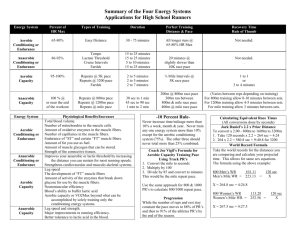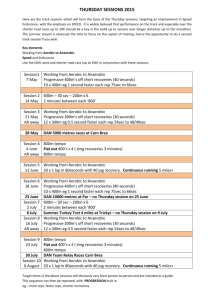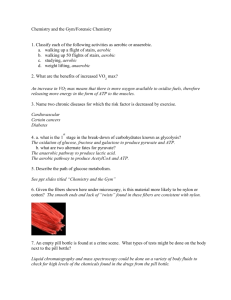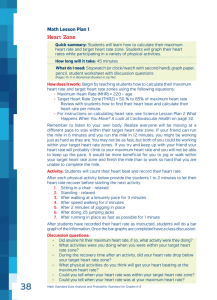The Carmel Distance Project
advertisement
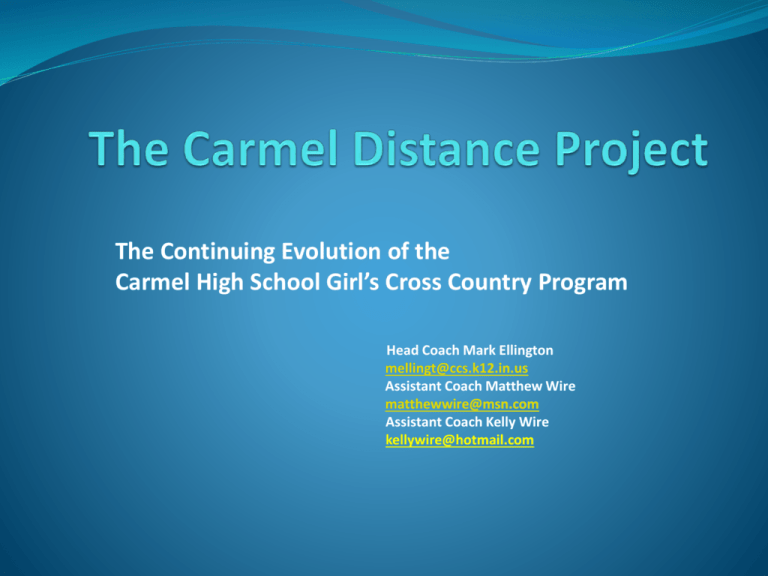
The Continuing Evolution of the Carmel High School Girl’s Cross Country Program Head Coach Mark Ellington mellingt@ccs.k12.in.us Assistant Coach Matthew Wire matthewwire@msn.com Assistant Coach Kelly Wire kellywire@hotmail.com Foundations of Success Tradition of Success Large, Motivated Group of Student-Athletes No Denying School Size is a HUGE Advantage Student-Athletes are High Achievers Community “Culture” of (Running) Success Pups Running, Middle School Programs, Club Program Top-Notch Medical Support Staff School Trainers St. Vincent Sports Performance Team Planning for Success Sound Coaching Philosophy (What do you want to do?) General Approach to Training High Volume vs. High Intensity Training Plan (How are you going to do it?) Application of the Philosophy Ability / Willingness to Implement Plan (Doing it!) DAILY Commitment to Excellence Reflection and Adaptation (How Can it Be Done Better?) Willingness to Change (Day to Day / Season to Season) Different Athletes require Different Approaches Is Training Compatible with Current Research? Coaching Philosophy What do you want to do? Emphasis on Lactate Threshold and Aerobic Capacity Training The greater the Lactate Threshold, the further and faster an athlete will be able to go before slowing down! Our athletes don’t need to get faster, they just need the stamina to maintain their speed over a longer distance (5K) “Speed” kills! Traditional, short duration (anaerobic) “speed work” is physically more demanding and requires longer recovery time. Increased risk of injury with increase in intensity Align training with specific mental and physical challenges of the race distance Why the emphasis on Aerobicbased training? Aerobic vs. Anaerobic contributions to exercise Advances in measurement techniques, including muscle biopsies and nuclear magnetic imaging, have produced different results for the aerobic / anaerobic contributions to exercise than the classic values. These new studies, completed in the last fifteen years, have produced the new table below: Event Marathon 10k 5k 3k Mile 800m 400m Anaerobic % 1 3 6 12 23 40 57 Aerobic % 99 97 95 92 84 66 43 Shifting the Lactate Curve Training Plan How are you going to do it? Running Physiology and Optimal Training Zones Training Zone (Energy System) Aerobic Conditioning Anaerobic Conditioning Aerobic Capacity Anaerobic Capacity ATP/CP Easy Distance Lactate Threshold Medium-Long Intervals Short-Medium Intervals Short Sprints Aerobic Oxidation Aerobic Oxidation and Aerobic Glycolysis Aerobic Glycolysis and Anaerobic Glycolysis Anaerobic Glycolysis and the CP Pathway The ATP and the CP Pathways Effort of Running 65-80% HRM 87-92% HRM 95-100% HRM 100% HRM 100% HRM Speed of Running “Comfortable” 24-30 seconds per mile slower than 5K race pace 3K to 5K race pace 800m to Mile race pace 400m to 800m race pace Duration of Running 30 Minutes + 15 to 40 minutes 3 to 5 minutes 30 seconds to 3 minutes 10 to 25 seconds Recovery Time Needed None (Continuous Running) None for Continuous Tempo Runs or 1/8th the time of Long Repeats Up to equal the time of the Fast Repeat 2 to 4 times that of the repeat (depending on intensity) Complete Sample Workouts 5-10+ miles at “easy” pace 15 – 30 minute continuous tempo run or “cruise intervals” with short recoveries 6 X 1000m at 4K race pace with 500m “slogs” 8 X 200m at 800m race pace with 4 X the time for recovery 6-8 X 100m all-out sprints with full recovery Key race Training 10K (45%) 5K (20%) 3K (10%) Mile (5%) Description Primary Energy Pathway 10K (45%) 5K (60%) 3K (50%) Mile (45%) 5K (17%) 3K (35%) Mile (40%) Running Physiology and Optimal Training Zones Training Zone (Energy System) Aerobic Conditioning Anaerobic Conditioning Aerobic Capacity Anaerobic Capacity ATP/CP Easy Distance Lactate Threshold Medium-Long Intervals Short-Medium Intervals Short Sprints Aerobic Oxidation Aerobic Oxidation and Aerobic Glycolysis Aerobic Glycolysis and Anaerobic Glycolysis Anaerobic Glycolysis and the CP Pathway The ATP and the CP Pathways Effort of Running 65-80% HRM 87-92% HRM 95-100% HRM 100% HRM 100% HRM Speed of Running “Comfortable” 24-30 seconds per mile slower than 5K race pace 3K to 5K race pace 800m to Mile race pace 400m to 800m race pace Duration of Running 30 Minutes + 15 to 40 minutes 3 to 5 minutes 30 seconds to 3 minutes 10 to 25 seconds Recovery Time Needed None (Continuous Running) None for Continuous Tempo Runs or 1/8th the time of Long Repeats Up to equal the time of the Fast Repeat 2 to 4 times that of the repeat (depending on intensity) Complete Sample Workouts 5-10+ miles at “easy” pace 15 – 30 minute continuous tempo run or “cruise intervals” with short recoveries 6 X 1000m at 4K race pace with 500m “slogs” 8 X 200m at 800m race pace with 4 X the time for recovery 6-8 X 100m all-out sprints with full recovery Key race Training 10K (45%) 5K (20%) 3K (10%) Mile (5%) Description Primary Energy Pathway 10K (45%) 5K (60%) 3K (50%) Mile (45%) 5K (17%) 3K (35%) Mile (40%) Aerobic Conditioning Long, Steady Distance Training increased capillarization, improved running economy, increased fat utilization, improved mitochondria 10 miles maximum “longest run of the week” for younger runners Still considered a “workout” even though the intensity is lower and the pace “conversational” Often supplement Saturday races with long cool-downs to achieve this training stimulus Can also supplement lower running volume with structured cross training Running Physiology and Optimal Training Zones Training Zone (Energy System) Aerobic Conditioning Anaerobic Conditioning Aerobic Capacity Anaerobic Capacity ATP/CP Easy Distance Lactate Threshold Medium-Long Intervals Short-Medium Intervals Short Sprints Aerobic Oxidation Aerobic Oxidation and Aerobic Glycolysis Aerobic Glycolysis and Anaerobic Glycolysis Anaerobic Glycolysis and the CP Pathway The ATP and the CP Pathways Effort of Running 65-80% HRM 87-92% HRM 95-100% HRM 100% HRM 100% HRM Speed of Running “Comfortable” 24-30 seconds per mile slower than 5K race pace 3K to 5K race pace 800m to Mile race pace 400m to 800m race pace Duration of Running 30 Minutes + 15 to 40 minutes 3 to 5 minutes 30 seconds to 3 minutes 10 to 25 seconds Recovery Time Needed None (Continuous Running) None for Continuous Tempo Runs or 1/8th the time of Long Repeats Up to equal the time of the Fast Repeat 2 to 4 times that of the repeat (depending on intensity) Complete Sample Workouts 5-10+ miles at “easy” pace 15 – 30 minute continuous tempo run or “cruise intervals” with short recoveries 6 X 1000m at 4K race pace with 500m “slogs” 8 X 200m at 800m race pace with 4 X the time for recovery 6-8 X 100m all-out sprints with full recovery Key race Training 10K (45%) 5K (20%) 3K (10%) Mile (5%) Description Primary Energy Pathway 10K (45%) 5K (60%) 3K (50%) Mile (45%) 5K (17%) 3K (35%) Mile (40%) The Basics of Anaerobic (LT) Conditioning Training goal is 20 – 40 minutes of total work volume Jack Daniels, exercise physiologist Since recent research suggests that the lactate threshold is not an exact pace or intensity, there should be: Systematic Progression, in volume and intensity, over the course of the season Progression of Intensity over the course of individual workouts Cut-Down Runs, Progression Runs, and Cruise Intervals are all examples By slightly varying the pace / intensity of workouts, you will be more likely to “hit” appropriate targets, for a variety of your athletes, on any given day Anaerobic Conditioning Steady State, Tempo, Lactate Threshold and Cruise Interval Workouts Lactate Threshold is a “curve” and not a specific point, therefore it is beneficial to vary training paces/intensities We prefer “Cruise Interval” approach as it allows athletes to periodically re-focus their efforts and maintain intensity Longer duration “cruise intervals” are optimal for 5K race specificity 20-30 seconds slower, per mile, than 5k Race pace 20-40 minutes of total “work” volume Early Season – 2 X Mile @ Tempo intensity with 60 seconds recovery (<14 minutes of “work”) Mid Season – 4 X Mile @ LT intensity with 90 seconds recovery (24-28 minutes of “work”) Late Season – 2 X 18 Minutes @ Cruise Interval intensity with 4-5 minutes recovery (36 minutes of “work”) Running Physiology and Optimal Training Zones Training Zone (Energy System) Aerobic Conditioning Anaerobic Conditioning Aerobic Capacity Anaerobic Capacity ATP/CP Easy Distance Lactate Threshold Medium-Long Intervals Short-Medium Intervals Short Sprints Aerobic Oxidation Aerobic Oxidation and Aerobic Glycolysis Aerobic Glycolysis and Anaerobic Glycolysis Anaerobic Glycolysis and the CP Pathway The ATP and the CP Pathways Effort of Running 65-80% HRM 87-92% HRM 95-100% HRM 100% HRM 100% HRM Speed of Running “Comfortable” 24-30 seconds per mile slower than 5K race pace 3K to 5K race pace 800m to Mile race pace 400m to 800m race pace Duration of Running 30 Minutes + 15 to 40 minutes 3 to 5 minutes 30 seconds to 3 minutes 10 to 25 seconds Recovery Time Needed None (Continuous Running) None for Continuous Tempo Runs or 1/8th the time of Long Repeats Up to equal the time of the Fast Repeat 2 to 4 times that of the repeat (depending on intensity) Complete Sample Workouts 5-10+ miles at “easy” pace 15 – 30 minute continuous tempo run or “cruise intervals” with short recoveries 6 X 1000m at 4K race pace with 500m “slogs” 8 X 200m at 800m race pace with 4 X the time for recovery 6-8 X 100m all-out sprints with full recovery Key race Training 10K (45%) 5K (20%) 3K (10%) Mile (5%) Description Primary Energy Pathway 10K (45%) 5K (60%) 3K (50%) Mile (45%) 5K (17%) 3K (35%) Mile (40%) Aerobic Capacity Also referred to as VO2 Max Training Accomplished through the use of Medium-Long Intervals About 3k – 5K race pace 2.5 – 5 miles of actual “work” intervals Recovery should be 50-90% of the interval time to allow for a more complete recovery because if you run slower than 5K race pace, you’re heading toward LT training pace One workout per week is sufficient Short intervals aren’t nearly as effective as longer ones because you don’t accumulate enough time in the optimal intensity range with shorter intervals Example: 6 X K on 7 Minute “goes” Running Physiology and Optimal Training Zones Training Zone (Energy System) Aerobic Conditioning Anaerobic Conditioning Aerobic Capacity Anaerobic Capacity ATP/CP Easy Distance Lactate Threshold Medium-Long Intervals Short-Medium Intervals Short Sprints Aerobic Oxidation Aerobic Oxidation and Aerobic Glycolysis Aerobic Glycolysis and Anaerobic Glycolysis Anaerobic Glycolysis and the CP Pathway The ATP and the CP Pathways Effort of Running 65-80% HRM 87-92% HRM 95-100% HRM 100% HRM 100% HRM Speed of Running “Comfortable” 24-30 seconds per mile slower than 5K race pace 3K to 5K race pace 800m to Mile race pace 400m to 800m race pace Duration of Running 30 Minutes + 15 to 40 minutes 3 to 5 minutes 30 seconds to 3 minutes 10 to 25 seconds Recovery Time Needed None (Continuous Running) None for Continuous Tempo Runs or 1/8th the time of Long Repeats Up to equal the time of the Fast Repeat 2 to 4 times that of the repeat (depending on intensity) Complete Sample Workouts 5-10+ miles at “easy” pace 15 – 30 minute continuous tempo run or “cruise intervals” with short recoveries 6 X 1000m at 4K race pace with 500m “slogs” 8 X 200m at 800m race pace with 4 X the time for recovery 6-8 X 100m all-out sprints with full recovery Key race Training 10K (45%) 5K (20%) 3K (10%) Mile (5%) Description Primary Energy Pathway 10K (45%) 5K (60%) 3K (50%) Mile (45%) 5K (17%) 3K (35%) Mile (40%) Anaerobic Capacity Short-Medium Intervals (100m – 400m) Total “work” volume of 1-2 miles per workout Intervals lasting 30 seconds to 3 minutes Should be run at 800m – Mile race pace Recoveries should be 2-4 times that of the interval (Full) Central Nervous System (CNS) Adaptations Challenge but don’t overwhelm the CNS Mentally makes “race pace” seem easier Most benefits occur within 6-8 workouts so this phase can be relatively short Season Training Summary BASE PHASE - Pre-Season / Early Season (June – September) Aerobic Conditioning – Build Mileage and Volume Begin Progressive LT Training Strength Training STAMINA PHASE - Regular Season / Late Season (September / October) Maintain Long Run and Weekly Training Volume “Max Out” LT Training (40 Minutes) Short “Hill” Phase (Transition to VO2 Max Training) Continue Strength Training VO2 MAX Phase- Conference and State Tournament Season (October) Gradual Reduction in Overall Training Volume Continue “Peripheral” Strength Training Gradual Shift from LT emphasis to VO2 Max emphasis Focus on VO2 Max Training PEAK PHASE - Post-Season (November / December) “Max Out” VO2 max Training (6K-8K of total volume) Gradual Reduction in Strength Training Anaerobic Capacity Phase (2K of total volume) Ability / Willingness to Implement Plan Daily Commitment to Excellence There is no continuum of success. Nick Saban Head Football Coach, University of Alabama The Power of Progression and Patience Systematic Progression, in volume and intensity, over the course of the season leads to.... Progression of Intensity over the course of individual workouts leads to.... Patience and effort “management” during races You cannot out-coach or out-perform the limitations of human physiology! ...of the six teams that had the best days (at 2014 NXN), they ALL had one thing in common: They started out conservatively and moved up significantly AFTER the first mile (and continued to move up throughout the rest of the race). Rob “Watchout” Monroe / Dyestat Reflection and Adaptation How can we do this better? Ancillary Strength Training Injury Prevention (75%) “Strong bones, muscles, tendons, and ligaments are better able to withstand the rigors of high-level training”. Lower Leg Prep Leg / Hip / Glute Strength Core Strength Performance Enhancement (25%) Upper Body Strength Leg / Hip / Glute Strength Core Strength Loss of consistent training due to injury is, by far, the biggest limiting factor in achieving long-term Success! Glute Activation and Utilization Sprinter’s “GLUTES”… Distance Runner’s “glutes”… Glute Activation The glutes are the largest muscle group in the lower body, and the LAZIEST, when it comes to distance runners. Due to the fact that the glutes are under-utilized in distance runners, they must be activated and trained to contribute to the task at hand. Poor glute utilization and strength deficiencies can lead to injury and/or poor performance. Glute Activation Routine (prior to running) Lunge Stretch (Stretch Hip Flexors) Tight hip flexors can inhibit glute “firing” Two Legged Bridge (Abdominals then Glutes) Proper “sequencing” is very important Quadraped Hip Extension “Clam Shell” (Gluteus Medias) “Speed skaters” (Gluteus Medias) The Role of the “Regular” Season We believe....... Competition exacts a physical AND emotional toll on athletes Athletes have a finite number of top performances per season Therefore, we....... Closely monitor and/or reduce the number of regular season races for experienced athletes Provides additional experience for younger athletes Allows experienced athletes to focus on other things Maintain high level of expectations for everyone Training and expectations all geared toward goal races (regular and/or post-season) What’s on the Horizon? RECOVERY Calf Sleeves / Compression Gear To Ice Bath or Not To Ice Bath? Foam Rolling Two-A-Day Runs Nutrition / Sleep / Stress Not Just for Injured Athletes Anymore! Relatively risk-free way to supplement, or replace, running volume Many injuries can be traced to hip anomalies (Girls) Most High School age girls are hyper-mobile and require focused strength training in hip area Proper Periodization for Goal Races Planning Forward vs. Planning Backward Supplement Volume and/or Improve Recovery Hip Strength and Mobility Is the Inflammatory Response to Training desirable? Role of Cross Training “Mixed Reviews” from our current runners We plan “forward” until 4 – 6 weeks before goal race and then plan “backward” based on current circumstances Maximal Speed Development Year-round speed development? Use it or lose it? Questions? Head Coach Mark Ellington mellingt@ccs.k12.in.us Assistant Coaches Matt and Kelly Wire matthewwire@msn.com kellywire@Hotmail.com Good Luck with your upcoming seasons!
